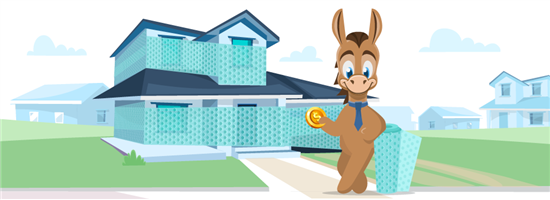Cheap Home Insurance
Home insurance rates vary greatly by insurer. Learn how to find the best deal on home insurance coverage without sacrificing coverage in our guide.
 |
Home insurance covers weather-related, non-weather, and accidental losses to your home. Finding cheap coverage means:
- Understanding what you're buying
- Finding ways to lower your insurance bill
- Choosing the best home insurance company
How can you find the best price for your needs? Read on.
What's a Reasonable Price for Homeowner's Insurance?
The average cost for homeowners insurance in the U.S. is $1,085 per year, while the average range is $600 to $2,000 a year.
Homeowners in states with a greater risk for hurricanes, wildfires, hail storms, tornadoes, and other natural disasters will pay more.
Other factors that influence the price are:
- Age of the home
- Building materials used
- Location, such as city vs. rural
- Coverages and coverage limits
The lowest cost states for homeowners insurance are Hawaii ($350/yr), Vermont ($590/yr) and Idaho ($624/yr).
*Data based on a policy with $200,000 dwelling coverage with a $1,000 deductible, $75,000 personal property coverage and $100,000 personal liability coverage.
Best Cheap Home Insurance Companies
 |
| © CreditDonkey |
The best homeowners insurance companies with the cheapest rates let you customize your policy. In other words, you save by only paying for the coverages that you need.
Keep reading to learn more about the top 3 homeowners insurance companies for cheap home insurance rates.
1. Liberty Mutual
With its motto "Only pay for what you need," Liberty Mutual Insurance leads the way with customized homeowners insurance.
Its standard policy includes must-have coverages and add-ons to suit your specific needs. Some options include:
- Inflation protection that increases as rebuild costs rise with inflation
- Coverage for valuables, like expensive jewelry, paintings, electronics, etc.
- Water backup and sump pump overflow
Liberty Mutual also offers plenty of discounts to lower your premiums, which we list below.
A.M. Best rating: A
J.D. Power rating: 805/1,000
Available Discounts: Claims-free, Safe Homeowner Program, Early Shopper discount, Newly Purchased Home discount, New/Renovated Home discount, New Roof discount, Multi-Policy discount, Insured to Value discount, Preferred Payment discount, Paperless Policy discount, Military discount
Consider checking customer satisfaction scores from J.D. Power, the BBB, and the NAIC, as well.
2. Farmers Insurance
Farmers has plans for every type of homeowner, including:
- The Smart Home Plan®: A starting point for highly customizable policies.
- Standard plan: Designed for the new homebuyer. It's the most affordable and includes standard home insurance coverages.
- Enhanced plan: For those with a greater investment in their home with extra features like roof replacement coverage.
- Premier plan: Farmers' best policy, includes the highest limits on personal property coverage and guaranteed replacement cost coverage.
You can further customize your policy by raising or lowering limits and adding/changing specific coverages.
A.M. Best rating: A
J.D. Power rating: 814/1,000
Available Discounts: Affinity, Multiline, ePolicy, UL-Approved Roofing, New Home, Protective Devices, Home Safety, Green certifications, Claims-free, Rent-to-Own, Preferred Payment, Good Payer, Military discount
- Declining deductibles up to $50 a year
- Claim forgiveness on the first claim you file if you remain claim-free for 5 consecutive years
- Discounts for home maintenance and remaining claim-free for 3 straight years
3. Progressive Insurance
Progressive Insurance's HomeQuote Explorer lets you create a homeowners policy to fit your budget. All you have to do is enter your address and answer a few questions to get started.
HomeQuote Explorer offers a side-by-side comparison of coverages and prices from other insurers. You can review the cost for a standard home insurance policy, plus any coverages you add on.
Lower your price even more with 9 available home insurance discounts. Some are easy to get, like one just for requesting an online quote from Progressive.
A.M. Best rating: A+
J.D. Power rating: 797/1,000
Available Discounts: Bundle Homeowners + Auto, Home Safety, Quote-in-Advance, New Purchase, Pay-in-Full, Receive Documents by email, New Home construction, Single deductible, Progressive contractor networks, Military discount
4. State Farm Insurance
State Farm is among the most popular homeowner's insurance companies, due in part to their high quality of customer service and the amount of personal property that is covered.
In addition to your home coverage, they offer coverage for all your keepsakes, outdoor & garden items, plus hobby equipment, like musical instruments or tech gear.
State Farm also protects you from nature threats, fire, theft and vandalism, and other causes of damage like plumbing or electrical issues.
A.M. Best rating: A++
J.D. Power rating: 829/1,000
Available Discounts: Multi-policy, Home Alert Protection discount, Roofing discount, Higher deductible
How to Find the Cheapest Home Insurance
To find the best deal on home insurance, you'll need to shop around. Here are two ways to get you started:
Use Online Comparison Tools
Compare quotes from many companies right from your laptop or mobile device. You'll need to enter some basic information about you and your home then select your coverage preferences.
Based on those details, you'll receive quotes from numerous home insurance companies. Review coverages, research the insurer, and move forward with purchasing a policy when you're ready.
Get Help from an Agent
If shopping for home insurance online isn't your thing, you can obtain multiple quotes by contacting an independent insurance agent. These agents research and compare the rates of numerous companies to find the best one to suit your needs.
Before deciding on a home insurance policy, be sure to:
- Review the coverages, amounts, deductibles, and other policy details.
- Check the home insurer's credentials. Look for an "A" rating or higher from A.M. Best, Standard & Poor's, or Moody's.
- Read customer reviews from online sites and the Better Business Bureau.
Top 5 Ways To Lower the Cost of Your Home Insurance
 |
| © CreditDonkey |
Home insurance is customized to the unique needs of homeowners. That means you have some freedom to control the price of your home coverage. Here are 5 ways to lower the cost of your home insurance premium.
Some home insurance costs less because it doesn't provide the coverage you need. Other cheap policies have important restrictions, limitations, or exclusions. That means you could pay more out of pocket if losses occur.
Be wary of home insurers advertising really low rates. Carefully check to see if:
- The policy provides the five basic coverages.
- The coverage amount is adequate.
- The deductibles are too high.
- The company is legitimate. Fake insurance companies sell home insurance to hundreds of thousands of consumers countrywide, according to the U.S. Government Accountability Office (GAO).
Buy Only the Amount You Need
You want your home put back to its present state after a loss. But there's no need to pay for higher limits you won't use. Determine how much coverage you should have by estimating:
- The cost to rebuild your home at the current rate with similar materials and labor costs.
The amount to rebuild is NOT the same as your home's market value or how much you paid to purchase or build it. A home insurance agent, professional estimator, or builder can help you determine the actual replacement cost.
- The rebuild cost for other structures on your property
- The cost to replace your belongings
- An appropriate amount of personal liability protection and medical payments to others.
You'll also need to decide which replacement value you want: actual cash value, replacement cost, guaranteed replacement cost, or extended replacement cost.
Take as Many Discounts as You Can
Home insurance discounts can take 5% and 10% off your premium amount. Look for companies that offer a variety.
Here are some of the most common discounts:
- Claims-Free
- Customer Loyalty
- Military
- Multi-Policy
- New or Renovated Home
- Protective Devices
- Central Fire Alarm
- Automatic Sprinkler System
- Central Burglar Alarm
- Local Burglar Alarm
- Smoke Detector, Deadbolt Locks, and Fire Extinguisher
- Controlled Access Community or Building
Be sure to ask about any available discounts before you purchase or renew your policy. They won't be automatically applied to your policy. And some require you to submit documentation to qualify.
Increase Your Deductible
A higher deductible can significantly lower the cost of your home insurance. Here's a look at how much you can save, according to the American Institute of Certified Public Accountants:
Increasing a $250 deductible to $500 = 10% savings
Increasing a $500 deductible to $1,000 = 24% savings
Increasing a $1,000 deductible to $5,000 = 37% savings
Just be sure that you can afford the deductible you choose in case a loss occurs.
Update Your Policy Yearly
Many homeowners let their home insurance policy renew automatically every year. But a lot can change in 12 months that may affect your premiums.
Here are some examples:
- Your valuables depreciate, so you might save by lowering personal property coverage limits.
- You purchased or upgraded home security or safety devices that qualify for a new or greater discount.
- You got rid of certain home features that increase rates, such as trampolines and hot tubs.
- You removed old, deteriorating structures, such as an old shed, from your property.
- Your income increased, so you can now afford a higher deductible.
- The policy includes coverage you no longer need.
Always review your policy before renewing. Otherwise, you risk leaving extra savings on the table.
Change the Way You Pay
Many home insurance companies provide incentives for how you pay your bill. Here are some ways you can save:
- Pay in Full
Save between 5% and 10% if you pay your home insurance bill in full rather than monthly or biannual installments. - Set Up Automatic Payments
Save up to 10% by setting up automatic payments online. It's also a good way to avoid late fees or a lapse in coverage. - Go Paperless
Discounts range from 2% - 5% if you sign up for paperless billing. Plus, you're helping the environment by going green.
With cheap home insurance, the goal is to get good coverage at the lowest price from a well-established company. But how do companies decide what you'll pay? Read on to learn more.
How the Price of Home Insurance Is Determined
Home insurance companies determine coverage rates based on these factors:
Where the Home is Located
This encompasses the country, the region, the state, the area within the state, and the neighborhood. Homes in areas with a greater risk to weather events or crime will pay more for home insurance.
Type of Home
Single-family homes are rated lower than multifamily residences. Additionally, if you live in a mobile home, your home insurance options will differ; be sure to confirm that the company's homeowner insurance offerings apply to mobile homes.
Frame Construction
The type of building material used to construct the home is rated based on how well it will perform. For example, a home with a wood frame construction would be more at risk in a fire than one made of brick.
Year Built
Typically, older homes are rated higher. As a home ages, its structure might weaken from years of weather events. This rating information is used to determine the cost of your home insurance coverage.
Home Insurance Basics
 |
| © CreditDonkey |
Understanding what you're buying is the first step for getting the best home insurance rate.
You need to know:
- What the policy covers
- How much coverage it provides
- What you have to pay out of pocket before coverage kicks in
- If there are any coverage limitations
Let's take a look at each one in more detail.
What the Policy Covers
A homeowner's insurance policy is comprised of 5 basic coverages:
- Dwelling Coverage
This is defined as the physical structure of your home and its attached structures. For example, say your home has a garage, deck, and front and back porch attached to it. All of these structures are typically included in dwelling coverage because they are actually attached to the house.Dwelling insurance pays for repairing or rebuilding the structure if it's damaged by a hazard covered by the policy.
Some hazards that fall under dwelling coverage are:
- Fire and smoke
- Hail
- Theft and vandalism
- Explosions
- Lightning strikes
- Falling objects
- Damage from a motor vehicle
- Damage from the weight of snow, ice, or sleet
- Damage from riots or civil commotion
- Damage from an aircraft
- Damage caused by home systems or appliances that stop operating properly
A home policy typically states whether the causes of property loss are covered as special or named perils.Special perils protection covers all hazards except those stated as exclusions. Typical exclusions are floods, earthquakes, mold, damages by animals or insects, and nuclear events.
Named perils protection covers only those specifically listed in the policy. Any hazard not listed means it is not covered.
- Fire and smoke
- Other Structures Coverage
This covers structures on the property that are not attached to the home. They might be a detached garage, shed, barn, or a fence. - Personal Property Coverage
Think of this as coverage for your stuff. It replaces the belongings in your home if they are damaged or lost by a hazard covered by the policy.The personal property category is wide-ranging, covering furniture, fixtures, appliances, electronics, clothing, jewelry, etc. Some companies, such as Lemonade Home Insurance, offer a low base rate and increase the costs only if the homeowner increases coverage on individual items.
To be sure you have enough personal property insurance, create a home inventory list. List all important, valuable, and expensive items with their cost and date of purchase.This includes electronics, appliances, furs, leather coats, jewelry, collectibles, etc. Take photos and keep receipts. Update your records as you buy new stuff.
- Personal Liability Coverage
This coverage financially protects you if someone gets hurt in your home or on your property. It also covers accidental damage caused to someone else's property by any member of your household.Personal liability coverage pays for:
- Bodily injury to a non-household member
- Property damage sustained by others due to your negligence
- Legal defense fees from a lawsuit against you from an accident in your home or on your property
Some examples of personal liability are:
- A visitor falls down your stairs and suffers an injury
- A friend sues you for damages after suffering a head injury from a falling object in your garage
Personal liability coverage also applies when members of your household are legally responsible for the harm. For example, your child is playing football outside. An errant throw breaks a neighbor's window and an expensive item inside.
The policy's coverage amount typically pays per occurrence. The minimum limit of liability the insurer will pay is usually $100,000.
You can usually purchase personal umbrella policies separately if your worth is more than $1 million. - Bodily injury to a non-household member
- Medical Payments to Others Coverage
This liability coverage pays for the medical expenses of anyone injured on your property.This coverage applies regardless of whether you or members of your household are responsible for the injury.
Most home insurance policies provide a minimum amount of $1,000 per person in medical payments to others.
How Much Coverage the Policy Provides
In addition to listing the coverages, a home insurance policy lists the amount of protection it will provide.
Next to each basic coverage, the policy displays a coverage amount. This dollar amount represents the limit the insurance company will pay for a covered loss.
For example, let's say a homeowner's policy has $450,000 listed as the coverage amount for the dwelling. If the cost to replace or rebuild your dwelling exceeds that amount, you are responsible for paying the overage.
That's why it's so important to make sure you insure your home for its replacement cost and not the market value.
Replacement Options
Most home insurers offer 4 replacement options for dwelling, other structures, and personal property coverages.
Actual Cash Value
Your dwelling and personal property are covered at fair market value. You are compensated for their replacement cost minus depreciation.
This option is the least expensive and will keep the cost of your home insurance down. However, in the event of a total loss, your home insurance policy will not pay out enough to rebuild your home as-is.
Replacement Cost
Coverage equals the amount it would cost to replace your dwelling and personal property. The insurance company would pay the amount it would cost to purchase them new at the time of loss. However, the amount is limited to the coverage limits stated on your policy.
Guaranteed Replacement Cost
This works like replacement cost coverage, but it can go over your policy's limits. For example, if replacing your belongings costs more than the coverage amount on your policy, the insurance company will pay the overage.
Extended Replacement Cost
This also pays over the replacement amount, but only up to 120% or 125%, depending on the policy.
What Is a Deductible?
A deductible is how much you have to pay for each covered loss before the insurance company will disburse funds. There may be one or more deductibles depending on the hazard.
Here's an example:
For hurricane windstorms, a home insurance policy might have a deductible of 2% of the total loss. But for all other losses, the policy has a flat $500 deductible.
A higher deductible lowers the price of your home insurance. That's because you are taking on more of the risk if a loss occurs.
What Are Endorsements and Limitations?
Most policies include endorsements that specify anything that isn't covered or events with limited coverage.
For example, a house located in a flood-prone area may include an endorsement stating flood insurance coverage is not provided under the home insurance policy.
Generally, most home insurance companies exclude coverage for:
- Neglect
- Sewer line backups
- Earthquakes
- Floods
- Sinkholes
- Landslides
- Mudslides
- War
- Nuclear disasters
- Damage caused by pests
Besides exclusions, many home insurers limit coverage for special weather or environmental losses. For example, a home insurance policy might limit coverage for hurricane windstorms.
What the Experts Say
CreditDonkey asked a panel of industry experts to answer readers' most pressing questions. Here's what they said:
Bottom Line
There are two types of cheap home insurance: policies that offer stripped-down coverage and policies that provide complete coverage at a price hundreds of dollars less than other home insurers. You want the latter.
The best way to find the cheapest comprehensive home insurance coverage is to shop around. Popular insurance companies include:
Additionally, you can take measures to lower your home insurance even more. Updating your coverages regularly, tapping into home insurance discounts, and increasing your deductible are just some examples.
By investing a small amount of time researching home insurance rates, you will find a company that provides the home protection you're looking for at the lowest price available.
Write to Maryellen Cicione at feedback@creditdonkey.com. Follow us on Twitter and Facebook for our latest posts.
Note: This website is made possible through financial relationships with some of the products and services mentioned on this site. We may receive compensation if you shop through links in our content. You do not have to use our links, but you help support CreditDonkey if you do.
Read Next:

